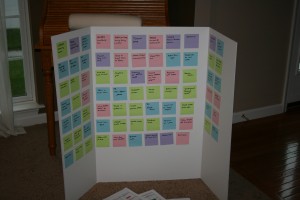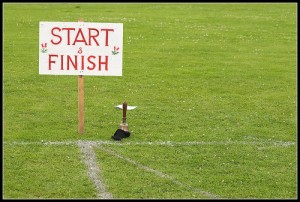Blog Posts
C is for Cry
At age 37, I had silicone implants put in.
Not in my breasts but in my tear ducts.
 I have had an issue with crying my whole life. I had a violent military birth with a forceps delivery that left me with a black eye, lopsided nose and clogged tear ducts. There are no pretty baby pictures of me and when a prettier, blonde “Smith” baby was presented to my parents by the nursery staff, they were honest enough to request their actual, ugly baby.
I have had an issue with crying my whole life. I had a violent military birth with a forceps delivery that left me with a black eye, lopsided nose and clogged tear ducts. There are no pretty baby pictures of me and when a prettier, blonde “Smith” baby was presented to my parents by the nursery staff, they were honest enough to request their actual, ugly baby.
During the crucial teen years, I had an evil step father who made it his goal to make everyone in the household cry. Therefore I made it my goal to not cry. Ever.
As a married adult, I can count on both hands the numbers of times I have cried. It is cause for great concern if my husband sees me crying–and like all husbands, he’d really rather not see me indulging in a sob fest.
And for me, the concept of indulging is key. Anger and tears are two emotions I don’t feel I can indulge in. And I hold a false, inappropriate disdain for those who can cry and benefit from it.
Apparently my lifelong practice of not crying has dried up my tear ducts. I have wore contact lenses since middle school. I am nearly blind without them but about two years ago, my eyes were irritated from the second the contact lens hit my eyeball.
After having silicone plugs put in my tear ducts and conducting some testing, it turns out I have defective tears. The average blink should coat your eye with tears that will last 13-15 seconds, before you need to blink again. My tears lasted less than 2 seconds.
I don’t know that my lack of crying actually sent my tears packing, but the result is a lifetime of wearing glasses. There is no brand of contact lens that will replace what can longer be generated.
Cry Little Children
But not crying isn’t a skill I want my children to inherit.
My children will indulge in a good cry. And it makes me happy. Just today, as Grandma and four cousins left for Michigan, Spencer shed some tears. He has a particularly sensitive heart and prefers to cry with Momma or Daddy in attendance. Delaney has sobbed over friendship slights, the death of pets and because her best plans went awry.
I have never encouraged them not to cry. I hope it is an outlet they are able to use, as needed. And perhaps some day my tears will come back. Until then, I will rock the implants and train a dry eye on my children–learning from their example.
What personal flaws do you have that you don’t want to pass along to your children?
Tomorrow’s post is about Doubt.
B is for Back Story
I do not understand what I do. For what I want to do I do not do, but what I hate I do. Romans 7:15
Back Story
I’m not one to typically quote Bible verses but I think this one is exceptionally true. I am obsessed with back story–both in stories and in life.
I appreciate movies and shows who create expansive universes and call on them to direct the action. I am especially impressed when the back story is a game changer but isn’t revealed until late in the story.
Some of my favorite examples:
In Buffy the Vampire Slayer (TV), it is revealed Angel has been watching Buffy for years prior their meeting. (Joss Whedon rocks at back story.)
In Final Cut (movie), one faulty memory is revealed–changing a man’s whole purpose and meaning in life.
In Memento (movie), the bad guy is not who we thought.
In Phantom by Susan Kay (book), we learn the real reason Erik is obsessed with Christine and how he came to know all his secrets.
In many of these cases, we thought we understood the character. We could predict how they could act. But as more of their back story was revealed, we learned more about their motives. They took new risks and changed directions, without contradicting our first impression of the character.
Excellent back story is an art form unto itself.
Personal Back Story
 Another reason I am obsessed with back story is because it is application in life. Or to be more accurate, I feel it should be applicable but I can’t figure it out.
Another reason I am obsessed with back story is because it is application in life. Or to be more accurate, I feel it should be applicable but I can’t figure it out.
If I understand another’s history, then I should be able to predict their actions with reasonable accuracy. But this is certainly a case where life is far stranger than fiction.
In my life, I have met a few people who exemplify evil. They suffered tragic pasts and as a result, they paid forward the evil they suffered. But I have also met loving, giving people–who have had equally tragic pasts. Why did one continue on a path of pain, while the other forged their own original trail?
But as the Bible verse implies, I can’t even predict my own behavior on a regular basis.
- I eat when I am angry. And I don’t always know why I am angry.
- I am self destructive in many unique ways.
- I act out of biases and prejudices that I don’t rationally believe.
- I don’t finish things–especially if it looks like it will be successful.
I have rather large holes in my past but even with inadequate information, I should be able to predict my own behavior. But often, I can’t.
In fiction, it is crucial to understand the character’s back story informs and influences his decisions. A deep dark secret can be revealed and further influence his trajectory but it can not contradict what we already know.
I am always on the look out for new books, shows and movies that demonstrate excellent back story. Do you have any to share?
Monday’s post will be titled Cry.
A is for Answers
I have been hesitant to commit to regular blogging because of one word.
Answers.
Since I have no handy capsules of educated advice to dispense, I feel unqualified to blog. I have no expertise on a singular topic. I don’t even have an opinion on several topics. I am woefully inadequate on the share answers and advice on the world’s problems.
And as an aspiring author, I often live in a world where I create more problems than I solve. In order to solve a particularly knotty plot problem, I can just modify my character’s background or their arsenal of solutions.
I have yet to succeed at solving the real life problems I have in my life and in the lives of others.
 Becoming a Tour Guide
Becoming a Tour Guide
I am not qualified to sit behind the information desk. But I can take you on the tour and smell the flowers with you.
I might not know the name of the cross street or the nearest landmark. But I am happy to marvel at the scenery with you. I forget the dates and times of the next show. But I’ll walk you there and we can talk along the way.
In truth, I am an expert at nothing. But I dabble in much.
I know very little. But I desire to learn much.
And I need advice more than I can give it.
But I can offer no answers. I barely understand the questions. I can only offer my view from my road, pointing out landmarks you might have seen. Or ones I suggest you avoid–speaking from personal experience.
Is it answers are you are looking for?
Then the information desk is over there. They know the answer to everything. But I am taking out a tour in just a few minutes. You are welcome to join us. The more the merrier.
Tomorrow: B is for Back Story
A to Z Blogging
I have joined the A to Z Blogging Challenge which starts tomorrow. Since National Novel Writing Month (NaNoWriMo) works so well for me, perhaps this will as well. To start off, I have completed this A to Z meme. Tomorrow’s blog post is ready and waiting but with a houseful of company, Saturday is already an issue.
A to Z About Me
A. Age: 38 until mid May.
B. Bed size: King. My favorite times are when all four of us are lying in bed, cuddled up in a ball.
C. Chore you dislike: I hate unloading the dishwasher, hauling laundry up and down three flights of stairs, and cleaning bathrooms.
D. Dogs: I am not a dog person. They are cute in photos but I’d rather not be in the presence of one.
E. Essential start to your day: Coffee in copious amounts.
F. Favorite color: Brown–weird, I know. I love warm coffee tones, cappuccino creams and dark chocolate brown.
G. Gold or silver: Both but after working in the jewelry business for so long, I prefer costume or handmade jewelry.
H. Height: 5 foot 5 inches. But I feel so much taller and gawkier. I was 5′ 5″ by age 10, towering over everyone, so I am still convinced I am too tall.
I. Instruments you play(ed): Trombone and French horn.
J. Job title: Copywriter by day, fiction writer by night.
K. Kids: Two.
L. Live: In Springboro, Ohio currently–a suburb between Dayton and Cincinnati. But I have also lived in Winston-Salem, NC; Stone Mountain, GA; Decatur, GA; Indianapolis, IN; Lafayette, IN: Marshall, MI; Spring Arbor, MI; and Union City, MI.
M. Mom’s name: Linda. But I call her Mom.
N. Nicknames: Nicki, Darlin’, Nik, Snickers, and N@
O. Overnight hospital stays: Two births but Spencer’s birth barely counts. I checked myself out after 11 hours.
P. Pet peeves: Tardiness and drama.
Q. Quote from a movie: “Darling, I don’t know how to tell you this, but… there’s a Chinese family in our bathroom.”
R. Righty or lefty: Righty.
S. Siblings: Two sisters and a brother. Countless steps and ex-steps.
T. Time you wake up: 6:30 a.m. almost always.
U. Underwear: Yes.
V. Vegetables you don’t like: Hominy makes me gag.
W.What makes you run late: 9 out of 10 times, my children. But they are usually good.
X. X-rays you’ve had: Oh good grief…broken toes, teeth, busted shoulder, broken tailbone, and ankle. Can you say klutz?
Y. Yummy food you make: I am a good cook by general consensus. I make a wicked turtle cheesecake, chicken and black bean quesadillas, Scotch eggs, tart cherry and cream cheese roll and homemade salted caramels.
Z. Zoo animal favorites: Bears, I suppose.
Check back tomorrow for the first post in the A to Z Blogging Challenge.
Writing Advice to a Young Girl, Part One
 A girl who is early in her writing career has been corresponding with me, asking wise questions. I try to give her answers that walk the fine line of realistic and encouraging. Here are some of my answers:
A girl who is early in her writing career has been corresponding with me, asking wise questions. I try to give her answers that walk the fine line of realistic and encouraging. Here are some of my answers:
Nothing New Under the Sun
After reading Hunger Games, my young friend was concerned with some strong parallels between her work in progress and Collins’ series.
I know there is nothing new under the sun, but how do you know if you what you are writing has been done before? I don’t want to be like another book. We all want to have a truly original idea, but is that even possible?
The short answer is no. There are no new stories to be told. But there are always new perspectives. So many stories fall into archetypes that seem to be overdone–yet new, compelling stories are told every day. The Hunger series is not new or even unique. It is retelling of the Minotaur. Harry Potter is a Messiah story and Titanic is Romeo and Juliet.
I highly recommend reading How to Read Literature Like a Professor. Even with formulas and archetypes, there are still individual ways to tell a story. This book does a very good job of showing you the commonality of different stories but never once suggesting that they rip off another first told story.
It matters very little that your IDEA has been written about. There are hundreds of books with public floggings (such as in the Hunger Games.) And rebellion and suicide and dystopian flavors. The goal is not to find a plot or a concept that has never been addressed.
Instead your task is much harder. You have to create characters (more than one) that are REAL. They are motivated, well rounded, flawed, perfect and they do your bidding. We have all read books that tell of government rebellion. But if you can make us care that your characters are risking life and limb—then we are seeing something new. If you can make us feel–you have a gift.
The things you do to the characters are rather limited. They can win…or lose. They can risk…or play it safe. In most action scene, they can go one way or another. As the creator, you can choose their reaction and the fallout.
But the recipe for a well developed character is endless. As endless as all the people in world. What are they scared of? What do they want? And why? What will they pay to get it? What is in their way? How do they get past it? These motivations plus the extras that make us unique–the likes, dislikes, quirks, appearance, hangups, history, etc. all add to the recipe.
And only YOU can create those characters.
Please know that you are not alone in the writing endeavor. Every early writer laments that all the good stories have been told. But a true writer–the one who sits in the seat at the keyboard and does the hard work of writing–knows that they have a story to tell. So they write it.
The Five Stages of Drafting
 November is NaNoWriMo (National Novel Writing Month), which makes it my favorite month of the whole year!
November is NaNoWriMo (National Novel Writing Month), which makes it my favorite month of the whole year!
As I approach my fifth year, I have found there are five distinct phases of pre-NaNo drafting and story percolation.
Giddy Excitement
My novel topics usually come to me in fits and starts. Experimental short stories or a big “what if” question can spur a novel topic. Dismantling Spider Webs, 2009’s novel, was founded on the question “what if the spouse you were cheating on died? How would you get forgiveness?”
However, this year’s novel, (working title) Zone Trippers, smacked me upside the head! A cacophony of characters and scenarios seemed to formulate in my head instantly. I suddenly understood what J.K.Rowling meant when she said Harry strolled into her, fully formed.
Overwhelming Unqualification
The second stage for me is always complete despair.I knew nothing about widowhood when I started Spider Webs. I wanted to do the topic justice–touching on every emotion and every problem a new, young widow faces.
Zone Trippers has its own stumbling stones. My characters find themselves spread out all over the world, having to adapt to their abrupt environments. I can research the slums of Calcutta and the factories in Belarus all I want but it easy to feel hopeless when I consider the sheer depth of what I do not know.
Diligent Research
After downing several chocolate infused reinforcements, I start researching.
For Spider Webs, I confounded the librarians by special ordering books on home improvement, how to have an extramarital affair and how to survive widowhood. I am sure they talked about me behind my back!
I am currently researching the nature vs. nurture debate, medical holidays, epidemiology, human trafficking and various obscure countries. I will never finish by the end of October but I will hopefully gain enough information to create a starting point for the book.
Pregnant Pause
I am an outline writer. I have a bare bones spreadsheet, outlining each of the major scenes of the book. But most importantly, I must know my characters. I have complete character sketches complete with photos for each character–major or minor. I am purposefully in choosing their names and their back story. Without their motivations, I can’t begin to write about them. Since the setting is often crucial to the story, I need that information written down as well.
All of these preparations are percolating in my head until I write them on index cards. Then I will rearrange and throw out cards while I write my spreadsheet. During the editing process, I tend to bring out the Post It notes so I can move the story chunks around.
The last two weeks of October has my fingers itching to start the new book.
I feel ready.
I am anxious.
I am impatient.
But because I want to follow the rules of NaNo, I don’t commit a single word until the Kick Off party. The flood of word that follows sets me up for an euphoric first two weeks of NaNo.
Hard Work
I have probably wrote the book ten times in my head before I commit the words to paper. Once the words take on ink and find a home on pulp, new surprises abound. I remember in Holiday Cards, the doorbell rang and I had no idea who was at the door. In Dismantling Spider Webs, I completed the whole second draft before I realized my protagonist was adopted–therefore driving most of her actions.
I am excited to see where Zone Trippers will take me. I have a plot. I am getting to know my characters quirks and flavors. The rising action has been decided but the ending remains a mystery–even to me.
This is the lure of NaNoWriMo–the bubbling thoughts, the new friends who live in your head, the Panera’s bagels and oceans of coffee, the paragraphs that snake across your computer screen and the heft of a printed novel in December.
Have you ever NaNo’ed? Care to join me?
Why Social Media is like Oatmeal
 Social media is a hot topic that can leave others cold.
Social media is a hot topic that can leave others cold.
Whether you use Twitter, Facebook and LinkedIn–or all three, please remember this following rule:
Determine how your audience uses their social media and follow suit.
This is one area where being a follower is good. If your readers, followers and/or friends are heavy users, it is okay for you to do the same. But beware the time-saving tools that make you appear like a self-involved, bellybutton gazing prat.
Just because Hootsuite and other aggregators allow you to post to multiple social media sites with a click of a button, doesn’t mean you have to!
Too Much
I recently stopped following an author who I have read and liked. I have followed her on Twitter for a while and recently added her to my Facebook Friends. Whereas I didn’t feel she over-Twittered, the 10-15 posts a day on my Facebook account were just too much.
Facebook is more of a personal communication tool. Adding endless links, a daily photo album, and a running commentary on your meals and snacks will clutter your reader’s feed. (Playing Farmville for hours on end doesn’t impress me either but I have hid the application.)
Too Little
If you have an account on a social media site but never use it, you are likely to get unfollowed or unfriended. (Don’t you love our new language terminology!)
Just like abandoned blogs and outdated posts, by posting too little, you will be ignored or unfollowed. This might not mean anything to you as a person but it should matter if you are a business.
Just Right
There is no exact number to suggest for proper social media etiquette. My personal decision is to post no more than once a day on Facebook and at least 4-5 times a day on Twitter. LinkedIn is used for big business-related announcements and book reviews.
Your decision should be based on your reader’s use, your purpose for using social media and–only minorly–your personal preferences.
Starting Gates and Finish Lines
This weekend is my 20th class reunion in Michigan. As the resident writer of our tiny class, I was asked to write the foreword to our reunion book. These were my thoughts:
At the Starting Gate
In the two short decades we have been out of high school, even class reunions have changed. Many mini reunions happen every minute on Facebook and across the internet. We don’t have to wait for chance encounters or an annual Christmas card to keep up-to-date with old friends. Long lost friends are only a click away.
Sadly, traditional class reunions are best known for offering up the chance to measure ourselves against others. Since we all had the same starting gate, those who are further along the path are surely winning.
Right?
In high school, we measured success by grades, future plans and ambition. None of us planned to stumble, trip or fail. Divorce and job loss happened to other people. Money woes wouldn’t dare to visit our doorstep and health concerns were for old people. Success was a breath away.
Now, with our own stumbles, it is easy—and natural—to grab a score card and start tallying before the first drink at the reunion is poured. We shared a starting gate—it’s only logical to expect the same finish line.
We think if she has more (or less) kids than me or if he has a better car and bigger paycheck, then they must be in the lead. If she can still wear a miniskirt (fashionable or not) and he still has all of his hair, they must be winning.
But in truth, we are not all striving for the same end goal. Even in our tiny class, we have city dwellers and country folks. We have worldwide travelers and homebodies. We have business people, the self-employed, teachers, factory workers, homemakers and students of life. For some, the ideal family size is 2.2 children—but others prefer five or more and yet others desire none. We have cat lovers, dog lovers and even oxen lovers.
None of us are going to die with equal checking account balances or the same list of accomplishments. We are not all on identical paths anymore. One classmate’s road may veer left while another’s course circles back before angling right.
It is futile to compare dress sizes, social status or bank accounts. The currency is no longer sameness—but contentment.
Small, Sweet Things
Life hasn’t always been as we expected.
We had grandiose plans in high school and no reason to believe that we couldn’t achieve each and every one. The future wavered before us in a golden haze.
Some of us have been visited by true tragedy. We have lost parents, children, jobs, faith and sometimes hope. Others have been ground down by small things like gritty sandpaper.
Even those of us who would categorize the glass as overflowing have had our moments of surreal disbelief, questioning our paths.
Am I heading in the right direction? Is any of this worthwhile? Why do other people seem to have it so much easier?
We work—some in careers meticulously planned out while others in jobs we stumbled into or merely tolerate. Others still are searching—in a dismal job market that stands in stark contrast to the decadent 90s.
Many have found themselves in school halls again—a new adventure with creakier bones. Some live vicariously through their students or through their children.
Each milestone we pass—graduation, college degree, new job, new baby, school vacations, new grandbabies—each one makes us think we should be racing against someone. We compare our intimate, messy interiors with the glossy façade of others.
Twenty years ago, we left the halls of Union City High School cocky, arrogant and confident—a golden path at our feet. Now—marinated in the daily-ness of life—few of us feel the siren’s call of the BIG things in life.
Instead we have learned to relish the small, sweet things:
- A good book
- The smell of water on tomato plants
- A household project checked off the Honey-Do list
- Dinner out on pay day
- Hand addressed “real” mail
- Fall nights with football echoing in the distance
- Summer rains that scrub away the humidity
- Family get-togethers when everyone gets along (!!!)
- Warm towels
- A hug that squeezes the breath from you
- Answered prayers
- Firefly glitter in a corn field
- A clean car and a full tank of gas
- All the laundry done, folded and put away
- Riots of color in the spring
- Fresh downy snow disguising the landscape in winter
- Date nights
- A shoulder to cry on
- A balanced checkbook
- Hammocks in the breeze
- The smell of burning leaves
- Friends who knew us 20 years ago and still want to know us 20 years later
Class reunions aren’t about comparing and measuring ourselves against one another. It’s about remembering that first starting line where we all stood together over 20 years ago—and discovering what finish line each of us have chosen for ourselves now.
Ready. Set. Go!
Color Coded Editing
 Editing has turned out to be a tangled, complicated experiment. And my only defense is $5 worth of colored Post It Notes.
Editing has turned out to be a tangled, complicated experiment. And my only defense is $5 worth of colored Post It Notes.
When I started Dismantling Spider Webs (DSW) last year, I had a fully fleshed out outline with all my sub-plots, character motivation and satisfying conclusion. It was condensed to a clever Excel spreadsheet and everybody fit nicely into their cells.
Darren of Wordsworth and editor extraordinaire, ate noodles with me and gave me all sorts of fun ideas on what could happen. He helped shape the ending and made several astute modifications to my original trajectories.
Prior to starting DSW, when it was still incubating in my mind, I took a writing intensive with novelist, Katrina Kittle. Her insight on dialogue, plotting, tension and motivation helped to poke holes in my outline. And I heard her voice as I wrote, guiding me towards less exposition and more authentic dialogue.
Writing DSW was effervescent! The characters ran willy-nilly across the pages, surprising me with thing they said and pranks they pulled. Three characters fell off the page, never to return again. One character begged to have her own book. (I am seriously considering her request.) And even in its sloppy, messy conclusion, I had a good rough draft.
But it is entirely prohibited from human consumption. Like uncooked puffer fish, it might kill you if you read it in its unfinished state. But there was promise there–buried under rudimentary words and cliche. With proper editing and several red pens, I dreamed it might be redeemed.
Enter the editing phase
I wish I liked editing more. When I am actually doing it, it’s not so bad. But the process makes me feel stupid.
I know these characters intimately. But I can’t remember if I referred to Lorelei’s adoption on page 12 or page 32. Is her nickname explained by Chapter 9 so can I use it in Chapter 10? Did the reader know her hair was long before I had her cut it off in a pivotal scene?
When I started DSW, Lorelei hadn’t been adopted. She did things with a certain lack of motivation. But after letting my brutal (but kind) friend, Jeanne, smack around my plot and characters, I realized she needed a defining reason to act the way she did.
So now there are new motivations, better designed characters, a few condensed characters, a reordering of plot points and more scenes to write. The only way I can keep it straight in my head is by diagramming it in Post It notes.
I am still holding onto the thread of hope that DSW is redeemable. And I sincerely hope this isn’t all just a “good learning experience.”
And I hope CVS doesn’t run out of Post It Notes.
Tortured Writers and Suicidal Artists
(Blatantly stolen from Jon Acuff at Stuff Christians Like. Check out his new book by the same title.)
This is a long video (almost 20 minutes) but it includes a wonderful message on how creativity and our life’s purpose is found outside ourselves.
I know I can feel overwhelmed about the next steps, the validity of writing a worthless book and the pressures of (potential) success. I have often said I need to get 10 books under my belt before I let anyone even see one. It is easy to be paralyzed with fear.
But if I only need to show up at my job by sitting down at the computer and type out the words that have chased me down–the pressure if off. There is still much to be said about the daily discipline of writing and marketing. But success isn’t found in a book deal or a contest win. It is found in knowing I have accomplished my work for the day.

